
Lean Practitioner Support
Everything you need to successfully complete your Certification
How to be Successful
- Complete the required workshops
- Attend the Learning to Solve Problems online Project Coaching
- Pass the online test after each workshop
- Complete 1 Lean Application Project
Manager’s Guide
The Manager’s Guide outlines how leaders can support team members so they complete the certification as well as reinforce the learnings and behavior long after the training is complete.
ONline Account
Use your account to take tests, track progress, and access tools and templates. If you already had a login, we have not changed it. Your default username is your email and default passwords are 123456.
Test
All tests are “Open Book,” so you may use materials and notes from workshops.
- Go to you My Account page
- Click on your certification program
- Scroll down to the Test section
- Issues: contact Sue Moldenhauer, suem@mfrall.com
Project
Applicants must demonstrate their ability to apply techniques learned and show at least one (1) positive measurable result. If you have questions contact Jeremy Blake or schedule coaching using the calendar at the bottom of this page. jeremyb@mfrall.com
Project Selection
Select a problem you would like to solve, not a “task” you need to complete. Some questions to ask when identifying a project topic are:
- What is stressing you out each day?
- What gets in the way of you getting other tasks done?
- What workarounds are you doing?
- What metrics are off track?
- What wastes are you observing? (The 8 Wastes)
11 Project Requirements
1: PROJECT INTRODUCTION/TITLE/SIGNATURE
What: Provide high level project information.
- Company name
- Applicant’s name
- Project name
- Company business description – 100 word max.
- Team participants’ names and titles
- Company sign-offs: names of applicant’s manager and 1 peer
Why: To provide general understanding of the company, who will be involved, and that your company supports you doing this project
Example:
Date
June 14, 20XX
Company Information:
Company Name: Core-Heat Technologies, Inc.
Applicant: Art Sneen, Manufacturing Cell Lead
Project Name: Meeting Customer Demand
Company Description:
Core-Heat Technologies, Inc., is an Anoka-based company of 110 employees with about $10 million in annual revenues. For over 55 years, the company has designed, manufactured, and marketed these products to world-wide customers involved in off-highway and marine markets. Core-Heat began to adopt Lean Manufacturing techniques in January 20XX.
Project Team:
| Name | Title |
| Bill Kerney | Manufacturing Engineering Manager |
| Dick Fettig | Production |
| Joey Lloyd | Production |
| Mark Mason | Department Lead |
| Tony Moline | Set-up Mechanic |
| Susan Schifke | Production |
Approvals:
| Manager: Brian Martin | Approval Date: 6/7/20XX |
| Peer: Larry Fong | Approval Date: 6/9/20XX |
2: PROBLEM STATEMENT
What: Define the problem using current state and target state metrics (numerical values) and providing the call to action (why it is important that you solve this problem) does not include root cause or solution speculation.
Why: To provide a common understanding of the project’s objectives, manage scope, and ensure support of decision makers.
Example:
From 8-1-20XX to 2-1-20XX our On Time Delivery has dropped from 95% to 85%. We have received notice from ABC Marine, our top customer, that if we are not able to meet their requirements of at least 95% On Time Delivery, they will need to consider switching to another supplier. ABC Marine makes up 25% of our annual revenue.
Resources:
“Writing Problem Statements” eCoaching:
3: PROJECT TIMELINE
What: Define the actions, their owners, due dates, and status.
Why: To provide a clear visual representation of the project’s schedule so you may ensure action items are on track, identify bottlenecks, and allocate resources effectively.
Example:
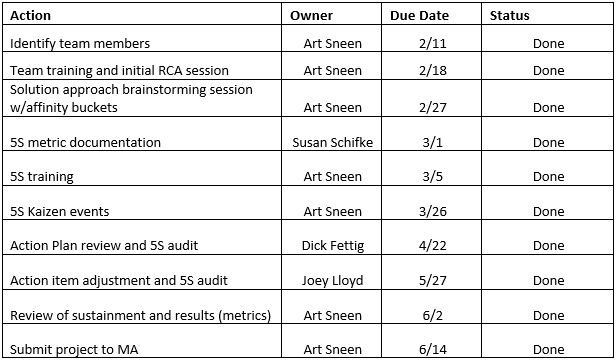
4: CURRENT STATE
What: Describe the current state conditions, documenting knowns and unknowns in relation to the problem you are trying to solve.
Why: To provide a more detailed account of the current state of the issue and it’s inputs, to aid in Root Cause Analysis.
Example:
The current OTD is 85%, falling short of the 95% target required by ABC Marine. The baseline 5S score is 35%, indicating significant opportunities for workspace organization. Die changes average 21 per week, contributing to inefficiencies, and the lead time is 10 days, which delays meeting customer demands. Known factors include extended setup times and unorganized workspaces, while unknown factors include potential inefficiencies in scheduling processes and material availability.
5: GOALS
What: The measurable goal(s) you plan to achieve, also include the current state metric.
Why: To provide team alignment, enable effective resource allocation, and facilitate progress tracking.
Example:
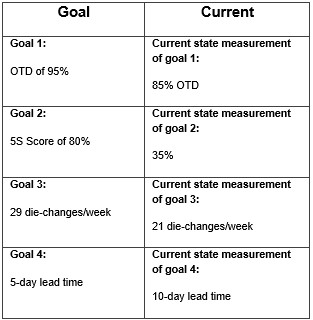
6: MAJOR PROJECT ACTIVITIES & CHALLENGES
What: List the key actions during the project, and the challenges you faced.
Why: To share the “story” of your project, from the planning stage through the implementation stage, and to aid in project completion reflections.
Example:
Planning Stage:
I received approval for the project at the end of January and spent some time determining who the participants should be, in consultation with the department supervisor. Brian and I then met with the team, and we explained Lean Manufacturing, why the area had been chosen, what the goals and timing were, and answered questions.
Action/Implementation Stage:
The project team received three days of training in mid-February on 5S, Visual Management (VM) tools, and Kaizen techniques. This included a Kaizen event on Press #3, to provide hands-on experience in using the 5S methodology, implementing VM tools, and the Kaizen method. After the initial training, I became the in-house Lean trainer for subsequent training sessions. I also held awareness-level training sessions for the balance of the sheet metal area and included the warehouse people. After the initial Kaizen, the team was anxious to complete the rest of the presses and the entire department. By the end of March, we had completed another three Kaizen events on the rest of the presses and completed a 5S on the entire department. We ended up including all other department employees in at least one 5S activity, even though the team had primary responsibility for completing the project. We changed the first-piece inspection procedure; the die-setters and press operators were trained to perform the first piece inspections and record their data. The run could then begin. QA still must sign off on the first part, and the last part. However, it saves set-up time, and we’ve had no bad runs. We 5S’d the die storage area and “red tagged” 35 of our 178 dies. We also placed in “temporary” storage another 12 dies that we weren’t sure about. (Their red tags are dated Oct 31 – if we haven’t used them by then, they get scrapped). We re-numbered and permanently marked all remaining dies and stored them in permanent rack locations. Because of the reduced number of dies, we took out 2 rack bays and moved heavy-duty racks in their place to store coil stock (RM) inside the press area, rather than in the warehouse. We designed and installed Communication Boards – 4’x8’ dry-erase boards that display daily Press area data. All relevant data is posted – quality, delivery, scrap, and productivity metrics, employee roster/photo, current and planned customer orders, color-coded drop boxes for warehouse personnel, current action plans resulting from Kaizen events.
7: LIST WORKSHOP SKILLS, TOOLS, & TECHNIQUES USED
What: The tools or skills from the workshops that you applied to your project
Why: To represent how you applied to the classroom to the real world
Example:
5S, Visual Management, Kaizen, Set-up reduction, Brainstorming and prioritizing.
8: RESULTS & FINAL CONDITIONS
What: Show the results compared to the goals, after impact of the project, don’t use TBD. “Goal” and “Current” sections will include the same information from the chart above
Why: To provide evidence of the project’s success, validate the effectiveness of the solutions implemented, and allow stakeholders to assess the overall impact and return on investment.
Example:
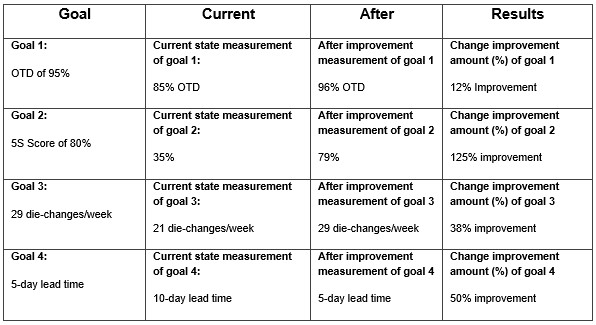
Resource:
“Results Vs. Actions” eCoaching:
9: SUSTAINMENT
What: Explain how the improvements will be sustained going forward
Why: To ensure the improvements that were achieved are maintained over time, prevent regression to old processes, and provide a clear plan for ongoing accountability and success.
Example:
Ownership of the process: Team leads in production and materials management will maintain updates to the visual scheduling board. Operators will own 5S routines to ensure ongoing organization.
Monitoring Plan: Weekly 5S audits will measure adherence to standards.
Monthly reviews of OTD, setup times, and 5S scores will track performance.
Potential risks to sustainment and mitigation strategies: Employee turnover could disrupt processes; cross-training and documentation will ensure continuity. Complacency in 5S and scheduling protocols will be mitigated through reinforcement in team meetings. Shifts in production demands may cause deviations; a flexible review process will allow adjustments.
10: CONCLUSION/LESSONS LEARNED
What: Reflect on key lessons learned throughout the project.
Why: To highlight what did and did not work well, identify areas of growth achieved and opportunities for future growth and improvement.
Example:
Lesson 1: Doing a better job of recording initial conditions and data. In some cases, we didn’t measure some critical things at all. Improvements were hard to quantify at first. Example: total die maintenance hours are much lower. However, we had no initial data.
Lesson 2: Spending more time with other employees affected by the changes. We would have had more support if we’d updated the other stakeholders more frequently.
How These Lessons Will Change Future Approaches: Future projects will emphasize early and frequent communication using visual tools to align teams. Operator involvement will remain a priority during planning and implementation phases to encourage buy-in. Greater emphasis will be placed on documenting baseline conditions to measure progress accurately.
11: APPENDICES
What: Supporting photos, notes, graphics or data charts.
Why: To provide clear, tangible evidence of actions taken, enhance understanding, and make complex information more accessible and impactful.
Examples:
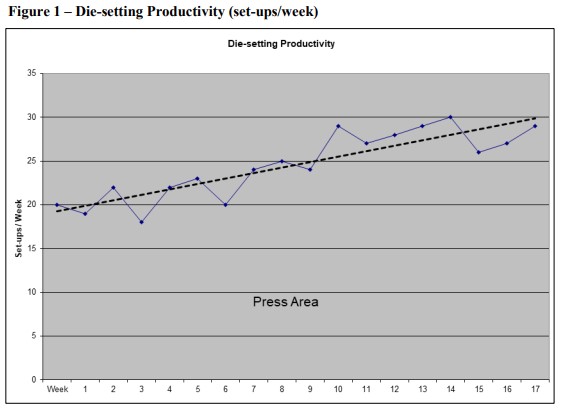
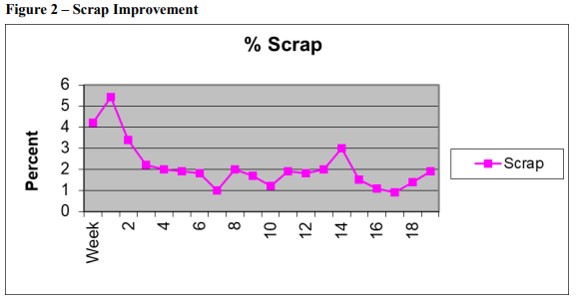
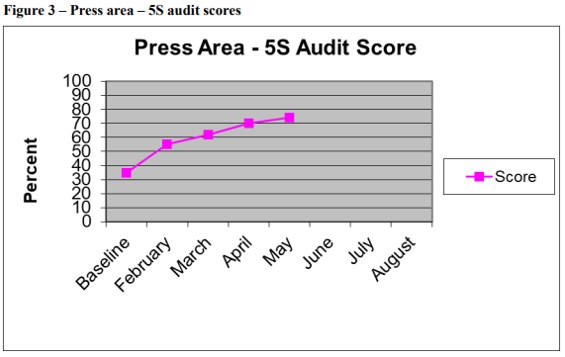
Project Evaluation Process
Submission of Project
Upload completed project via the “Submit Project” tab in your Manufacturers Alliance account.
Allow up to 5 business days for the review as outlined below.
Project Reviewer’s Criteria
- Was the project signed off as credible by the applicant’s manager?
- Is the project in an acceptable format with all requirements met, including at least one positive measurable result?
- Does the project demonstrate the applicant’s effective application of skills and tools from the certification?
- Is the applicant following up or measuring the right things to reach the stated objectives to solve the problem and sustain the results?
Reviewer’s Feedback & Certification Completion
Successful submission is followed by:
- A letter of completion with comments
- Updated online records on Manufacturers Alliance website
- A certificate of completion
- Unsuccessful projects will be returned for improvement and re-submission
